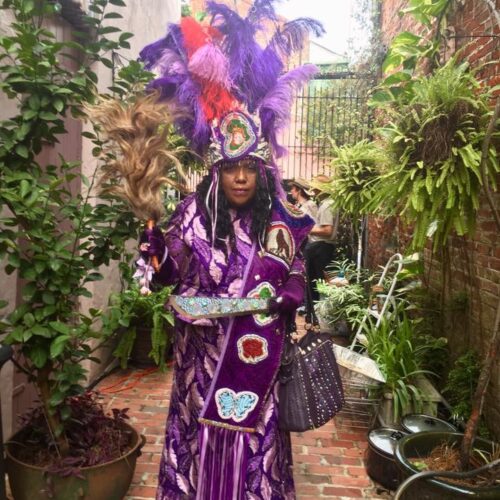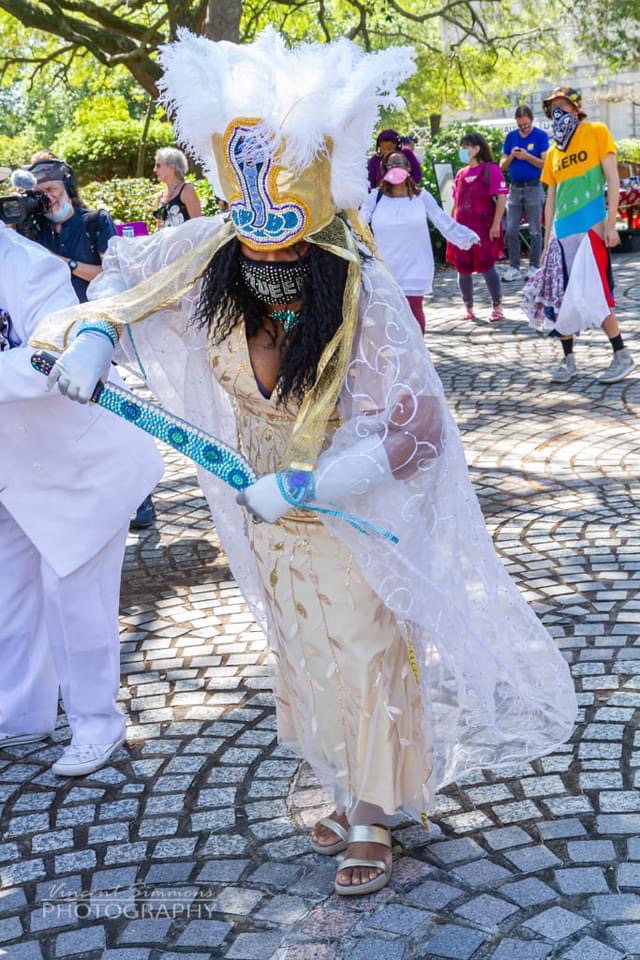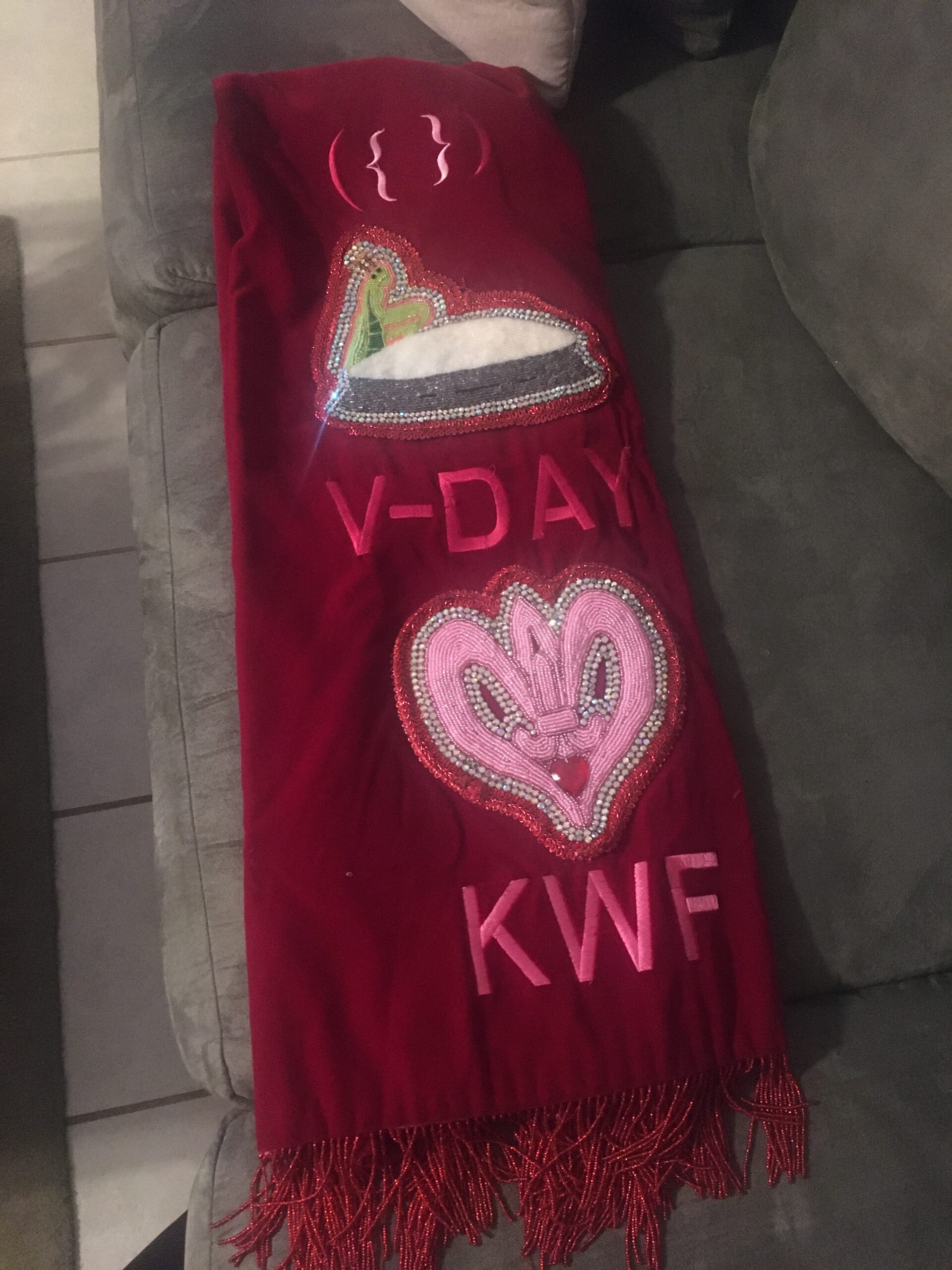Authors: Alejandra Rodriguez, Caroline Brenninkmeyer, Scott Leven, Cresin Williams-Quinn
New Orleans hosts many different cultural and food festivals that make it unique from all other major cities in the United States. Due to its historically deep French roots, Mardi Gras is one of the main celebrations that is celebrated solely in New Orleans. The French claimed ownership of New Orleans in 1682, and its cultural traditions remain prominent in New Orleans culture with the celebration of Mardi Gras. A subculture of New Orleans Mardi Gras are the Mardi Gras Indians. The Mardi Gras Indians are primarily Afro-Creoles or African-Americans who host Mardi Gras and St. Joseph’s Day parades to honor the Native Americans that took in, protected, and hid runways slaves from the translatlantic slave trade. Mardi Gras Indians also celebrate self-emanicaption from slavery through the establishment Maroon societies. The Mardi Gras Indians wear distinct suits with masks, colorful beads, and feathers, tributes to African and Native American culture, which represent the alliance between these two cultural groups and the identities of many Afro-Creoles in New Orleans.
Cherice Harrison-Nelson, also known as Queen Reesie, has been the Queen of the Guardians of the Flame Maroon Society in New Orleans for the past 30 years. She has inherited her position as Queen through her royal family line that has ruled the Maroon Society for the past 35 generations. Our documentary focuses on her experience as a part of the Maroon society and the cultural traditions and values she practices. Through our interview, our group gathered information about her family history, cultural attire and rituals, and the historical background of the Maroon Society in New Orleans.

Queen Reesie in a Maroon Society Suit
The Maroon Society was created in New Orleans during slavery as a community of self-emanciapted slaves that built settlements on the borderlands of the plantations or in the swamps. While the most common narrative is that escaped slaves were taken in by Native American groups, this was not the case for all Maroon Society members. Queen Reesie speaks upon how this narrative perpetuates that Black people need to be saved rather than being able to liberate themselves. However, she also acknowledges ,“It is a tradition of resistance. It is an homage to the mutual struggles of both African Americans and Native Americans on their quest for freedom, self-actualization, and self-expression in America.” While Queen Reesie does not identify herself as a Mardi Gras Indian, she participates in Carnival Day parades representing the Queen of Guardians of the Flame Maroon Society.
Maroon Society members were excluded from Mardi Gras, which began in the 18th century, because of racial discrimiantion, thus they created their own celebration of Carnival Day or St. Joseph’s Day. This celebration was influenced by many freed Black people that migrated from Saint-Domingue, Haiti, and Cuba, to New Orleans. Mardi Gras incorporates many of the same core values and culture that the Maroon society exhibits. And as Rachel Breulin says about the origins of Mardi Gras, “Coming out of slavery, you’re not going to give us a place in society, we’ll create our own.”

Queen Reesie celebrating Carnival Day with her family and other Maroon Society members
There are many traditions that Maroon Society members practice that are deeply tied to African culture. Black Mardi Gras Indians that participate in the parades and wear traditional suits demonstrate the intersection between African, Indeigenous, and Creole identities through their attire and the celebration of resistance and joy in the limited displays of freedom. (Guthrie, 2016) The suits are decorated with a vast variety of beads, feathers, sequins, fringe, and patches that are inspired by Native American culture. (Becker, 2013) Some suits have Caribbean influence due to the large Haitian immigrant population in New Orleans that incorporate sequins and beads in Vodou art and the belief that painted “ritual dots” are the opening for the living world and the spiritual world. Also, Dancing performances were ingrained in African culture that remained prominent during US slavery. In 1817, Sundays were the only days that slaves were allowed to be off work. Dancing at Congo Square was a restrictive past-time that allowed for expression of emotions and music through movement. Dancing is still an important performance aspect of parades as homage to the cultural ties of African dance and music.

Queen Reesie dancing at Congo Square
After Reconstruction, Jim Crow Laws in the South were heavily enforced, leading to housing segregation. Black free slaves were segregated from white Carnival krewes, so they hosted parades in these predominantly black communities in New Orleans. The tradition exists as a unique culture of creativity and self-determination. It provides a place for freed slaves to fully immersive themselves in the culture that they have been systemically marganilized for.
The creation of the suit is personal for each member that masks themselves. Masking is a spiritual experience of “ entering the spirit world of possession akin to catching the spirit in black church services or being ridden by a loa in voodoo service” (Fields, 2016) Masking is also the process of creating the suit that is worn at the parades. The designing and creation of a suit is a year-long experience that Maroon Society members partake in annually. On Mardi Gras Day & St. Joseph’s Day, masking incorporates dancing and chanting to enter into the spiritual world. celebrated. (Lipsitz, 1988) The dances, songs, performance, and suits all encompass the values of grace, strength, and dignity.

Memorial Adinkrahenes (Adinkra symbol from Akan People of Ghana) Representing the Circle of Life
Queen Reesie discusses her personal ties to the suit she creates during the interview. Queen Reesie emphasizes the symbolism of this tradition especially, and how deeply it connects her to her ancestry. “For every one, it’s personal”, she said while knitting her newest bright red “memorial” garment. This particular garment was sparked in part to commemorate her late dear friend, Doctor Silvia Fry, who passed away in June. “I was so devastated by her loss,” says Queen Reesie, “because every carnival morning, she came out to see me.” And so, to honor a lost loved one, and now, as Queen Reesie refers to her, an ancestor, she created a vibrant red garment, which were both Doctor Silvia and her late father’s favorite color. She decorated it with various symbols that connect her to her past ancestors. Some included a purple heart for her brother-in-law’s service in Vietnam, butterflies for her late friend Mr. Ike, and a blue eagle for her father. “All of my friends that have gone on to be ancestors in recent times will be represented on the suit.
 NOLAbeings Multimedia artist Claire Bangser created NOLAbeings as a portrait-based story project that marries...
NOLAbeings Multimedia artist Claire Bangser created NOLAbeings as a portrait-based story project that marries...  Voodoo in New Orleans: Reviving history: New Orleans fortune telling This article takes a deep dive into the history of Voodoo in New Orleans, its hybridization with Catholicism, and its present-day place in the city's culture. The author visits fortune-tellers in the French Quarter, using their guidance as a tool for introspection rather than a deterministic predictor of the future. Through her experiences in New Orleans, the author feels a mystical connection to both the past and the future.
Voodoo in New Orleans: Reviving history: New Orleans fortune telling This article takes a deep dive into the history of Voodoo in New Orleans, its hybridization with Catholicism, and its present-day place in the city's culture. The author visits fortune-tellers in the French Quarter, using their guidance as a tool for introspection rather than a deterministic predictor of the future. Through her experiences in New Orleans, the author feels a mystical connection to both the past and the future. 